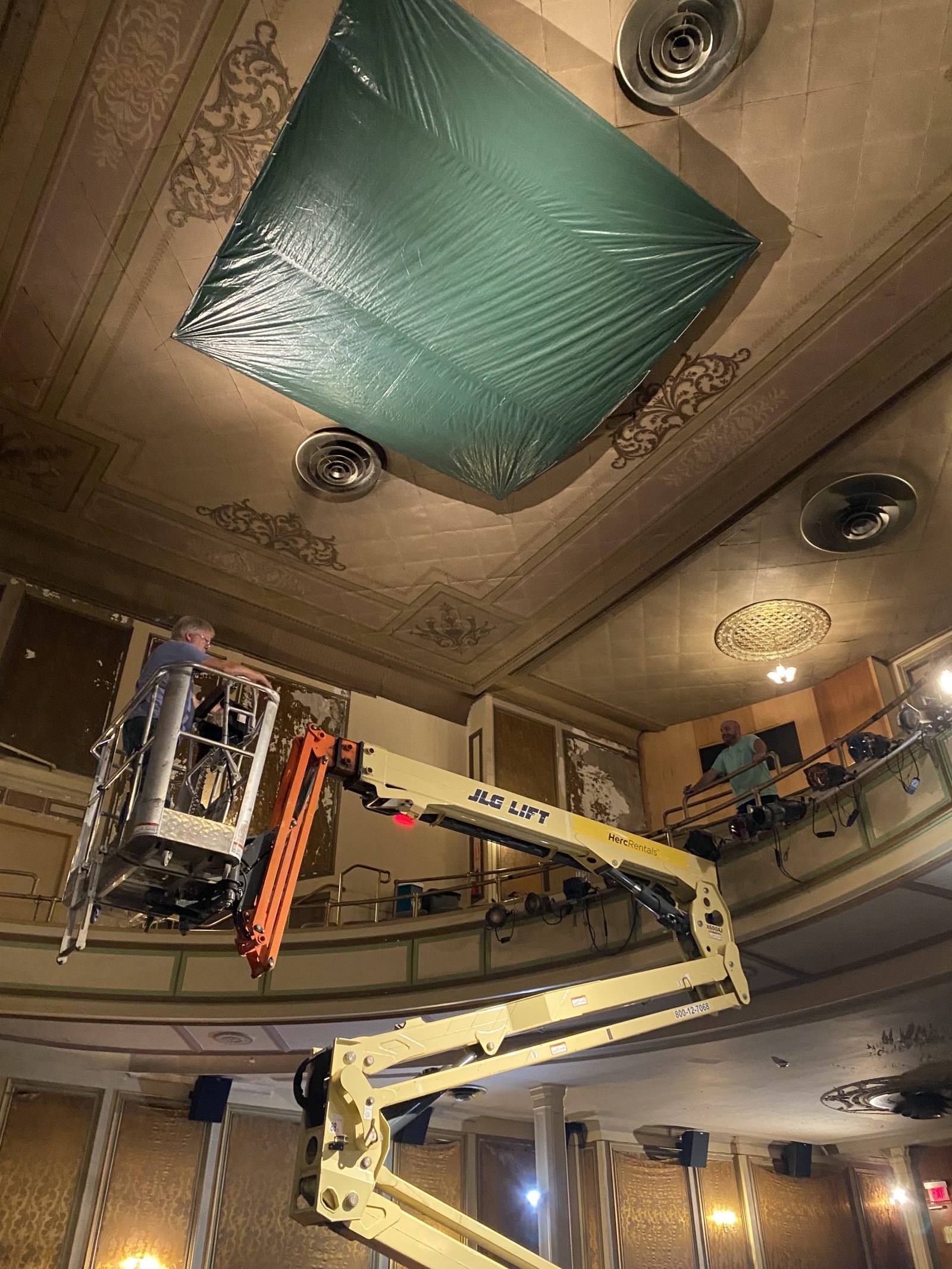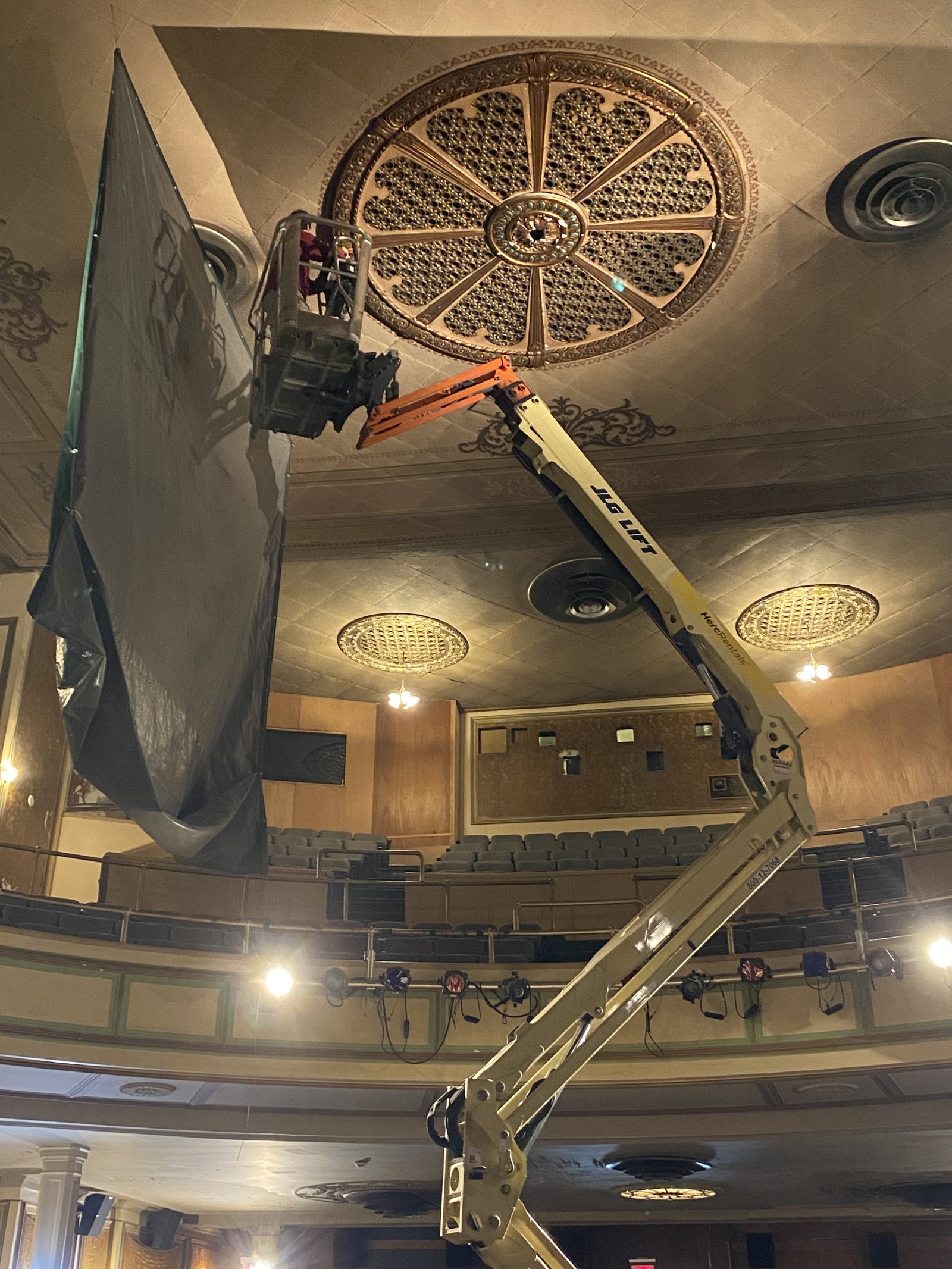In mid-2023 the Association for The Colonial Theatre’s Board of Directors approved the restoration of the 1903 theatre’s historic ceiling medallion–a magnificent design that is an iconic emblem of the theatre itself.
For far longer than anyone ever intended, the center of the 1903 theatre’s ceiling held an unsightly tarp. Its purpose: conceal the damaged medallion situated centrally above the venue’s 658 seats.

“We were digging in our files trying to figure out exactly when that tarp went up,” says Executive Director Jennifer L. Carlson. “No one’s really sure. What we do know is that it’s gone now. The medallion is back!”
Before the tarp could be permanently removed, though, repairs of an intricate and delicate nature were necessary. Repairs best trusted to experienced, artful hands.
Award-winning restoration and preservation artist Aaron Greene hails from a family of artisans, with generations of his family devoted to the architectural arts. Steuben County, NY-based A Greene Shop, run by Aaron and his wife Morgan, specializes in restoring historic sites, including theaters, churches, libraries, and museums.
Restoring The Colonial’s medallion presented a fair share of practical and creative challenges. First, how to reach it? The work needed to be done from beneath, so the only way to go was up. Seats were removed and a massive lift was carefully brought in and parked in the middle of the theatre. With this, Aaron could elevate himself in much the same way you see technicians working on power lines.
Once in place, more challenges were found–and addressed. “We had to pull the sections that were hanging from the ceiling back into plane with the ceiling as best we could,” states Aaron. “And then we used wire to tie them to the beams above. Then we patched the cracks that remained, where the gaps were, because it’s a multi-piece casting and cracks occurred across its entirety.”

“I tried to consolidate it, but it fell apart as I wet it, which is the first step of the consolidation.” At one point Aaron created–from scratch–detailed replacement pieces. “I had to re-glue all the pieces that fell off, as many of them as I could find, and then the rest I sculpted in plaster.””The challenges I came across were that the medallion, in the center, was completely shattered, probably from the removal of the chandelier,” says Aaron. “It was literally hanging on by a thread.”
After sculpting and sanding the new pieces, Aaron brought them into plane, primed them, and was ready to focus on color. Aaron always preserves existing elements as much as the restoration will allow. “The bronze color I kept original, as much as I could, but the center medallion had so much damage that it needed to be completely repainted, including the pearlescent spheres around the center.”
“I painted the flat areas in a matched color, completely new paint, and then the bronze on the larger outer ring, and the spokes of the medallion. And then in the center of the medallion, I used metallic paints.”
Aaron estimates that the rosette itself was from the original 1903 construction. He took this opportunity to reinforce the back of the center medallion with burlap and plaster. “For a project such as this,” states Jennifer, “we were fortunate to work with Aaron, who has decades of experience carefully restoring historic structures.”
Aaron’s detailed workmanship is already garnering praise from audiences who have, for too long, only known the theatre ceiling to hold a tarp. Now a bit of history has returned, and in vibrant form.
“The Colonial Theatre opened in 1903 to provide world-class entertainment to the working class people of Phoenixville and the surrounding area,” notes Jennifer. “This grand central medallion is a beautiful reminder of our past, and an inspirational symbol that our future is looking up.”
Please help us continue to restore and preserve The Colonial Theatre for future generations by making a tax-deductible contribution to the Building Improvement Fund.